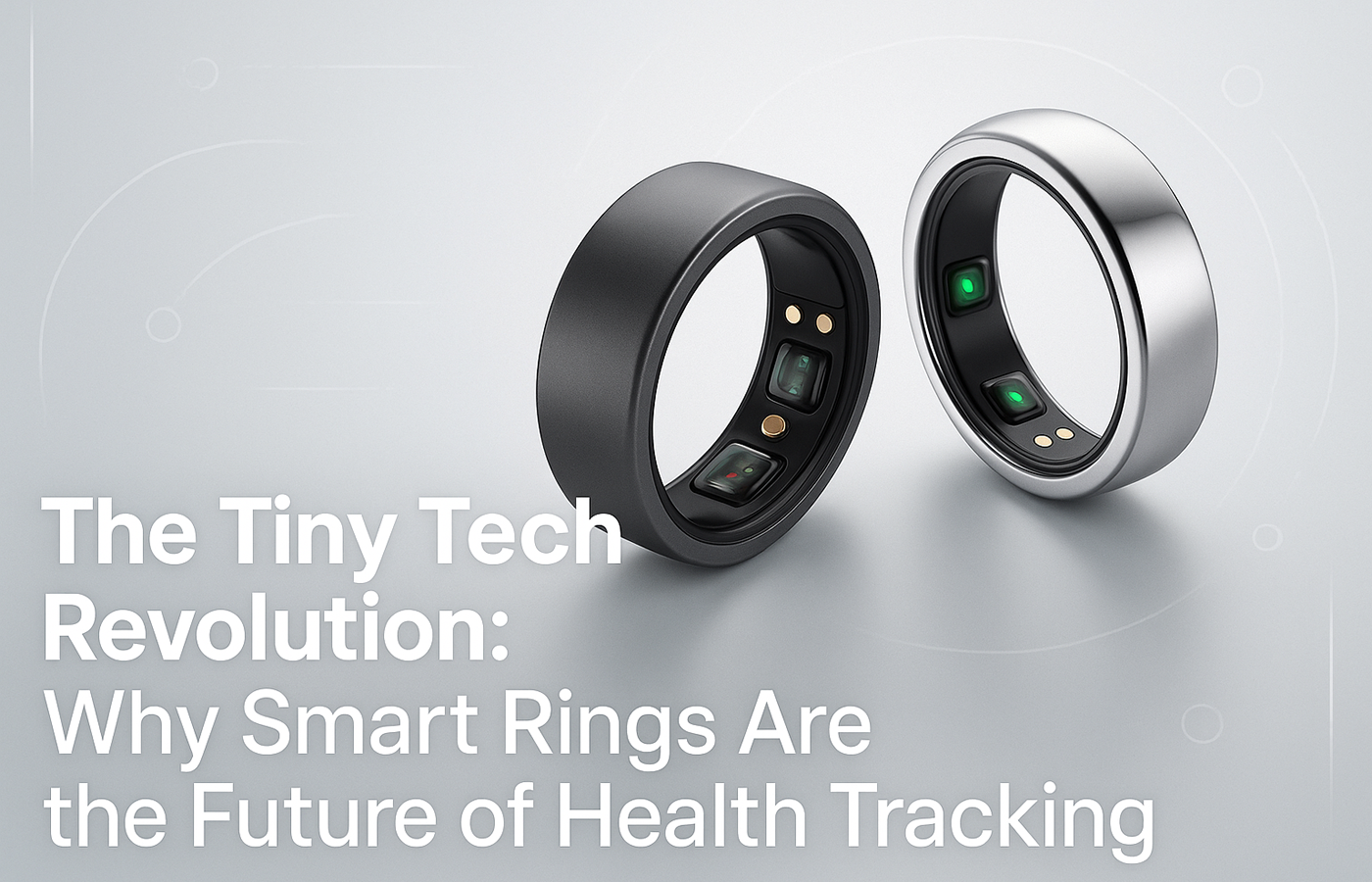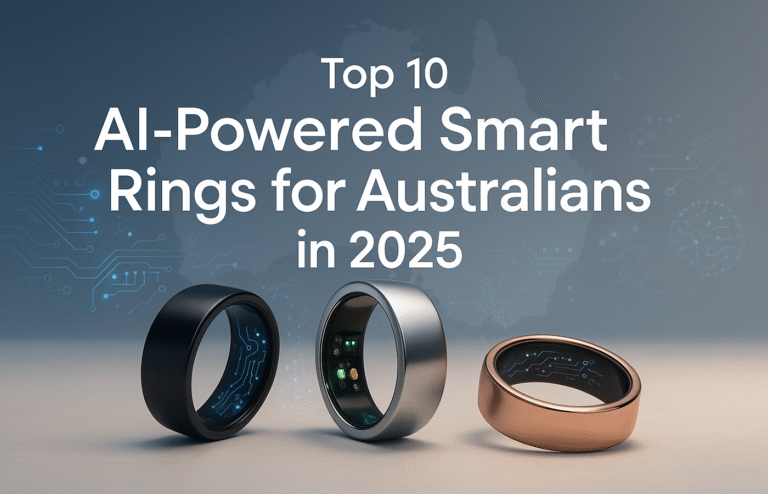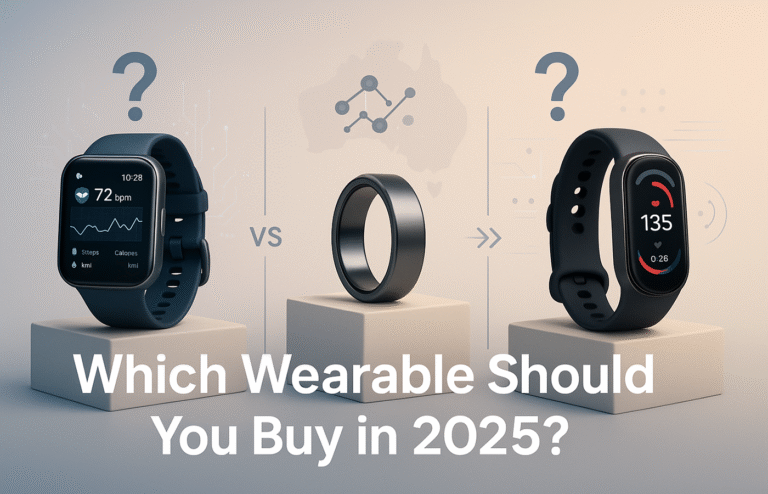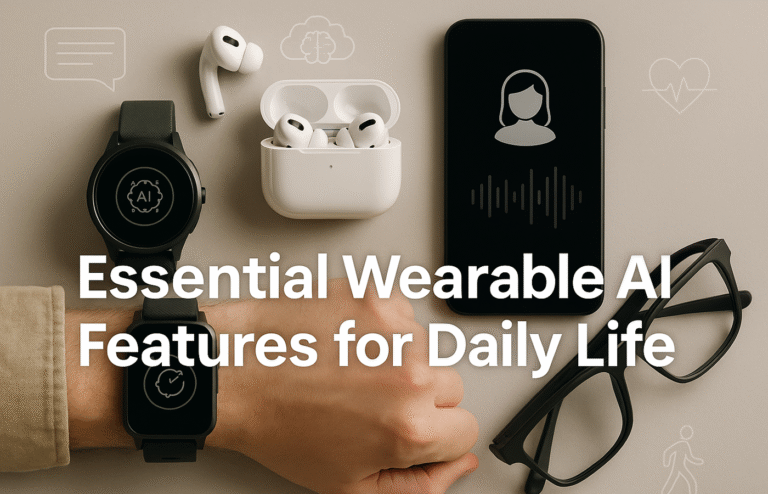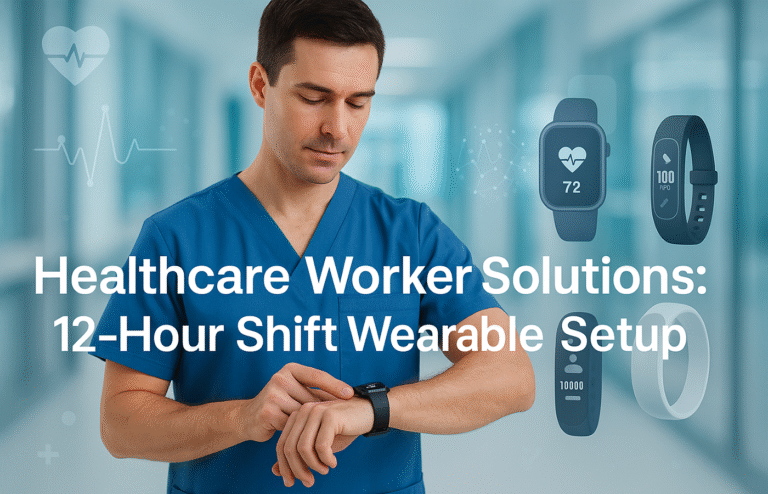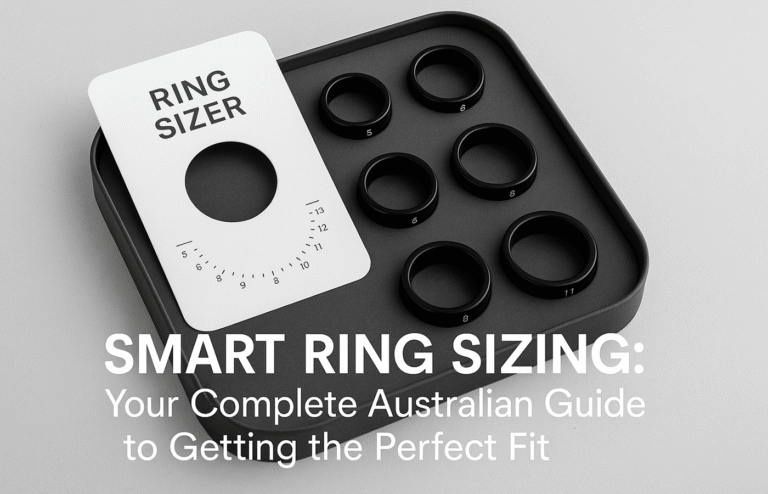The Tiny Tech Revolution: Why Smart Rings Are the Future of Health Tracking
Smart rings revolutionise health monitoring by combining sophisticated sensors with elegant jewellery design, offering comprehensive health tracking without the bulk, screens, or constant notifications of traditional wearables.
Key Advantages:
● Unmatched comfort and discretion enabling 24/7 wear through sleep, work, and formal events
● Superior battery life lasting 4-8 days versus daily smartwatch charging
● Professional appearance suitable for conservative business environments
● Exceptional sleep tracking accuracy due to optimal finger sensor placement
Leading Australian Options:
● Oura Ring 4: $549-649 AUD with comprehensive health insights requiring $9.99 monthly subscription
● Samsung Galaxy Ring: $699 AUD with no subscription fees and seamless Samsung ecosystem integration
Advanced Features:
● Daily readiness scores combining sleep quality, heart rate variability, and recovery metrics
● Women’s health tracking including cycle monitoring and fertility awareness
● Temperature sensors detecting variations as small as 0.1°C for circadian rhythm insights
Future Outlook: Represents fundamental shift toward discreet, continuous health monitoring fitting perfectly on your finger.
The Tiny Tech Revolution: Why Smart Rings Are the Future of Health Tracking
Picture this: you’re getting ready for bed, and instead of strapping on a bulky smartwatch that digs into your wrist all night, you simply wear what looks like an elegant piece of jewellery. Yet this unassuming ring is silently monitoring your heart rate, tracking your sleep stages, measuring your body temperature, and even detecting when you’re stressed. Welcome to the smart ring revolution – the most discreet way to take control of your health.
Smart rings represent a fascinating shift in wearable technology. Whilst smartwatches have dominated headlines for years, these tiny devices are quietly transforming how we think about health monitoring. They offer many of the same capabilities as their larger cousins but without the bulk, screens, or constant notifications that can disrupt your daily life.
What Exactly Is a Smart Ring?
Simply put, a smart ring is a wearable device that fits on your finger like traditional jewellery but packs sophisticated health monitoring technology inside. These devices typically measure heart rate, sleep patterns, activity levels, and body temperature using advanced sensors that are small enough to fit inside a ring band.
The two most prominent players in the Australian market are the Oura Ring 4 (available through online retailers for approximately $549-649 AUD) and the Samsung Galaxy Ring ($699 RRP), which launched exclusively in Australia through Samsung stores and website in late 2024.
Unlike smartwatches, smart rings don’t have displays, don’t buzz with notifications, and don’t need daily charging. Instead, they focus purely on health monitoring, sending all data to your smartphone app for analysis and insights.
The Sleep Tracking Revolution
Perhaps nowhere is the advantage of smart rings more apparent than in sleep tracking. Traditional fitness trackers and smartwatches can be uncomfortable to wear to bed, often resulting in poor sleep quality or users simply taking them off at night – exactly when sleep monitoring is most valuable.
Why Your Finger Knows Best
Smart rings excel at sleep tracking because your finger provides an ideal location for monitoring key physiological signals. The ring sits close to arteries, allowing for accurate heart rate and heart rate variability measurements throughout the night. Moreover, the finger is an excellent location for detecting subtle changes in body temperature, which fluctuate naturally during different sleep stages.
The Oura Ring 4 has revolutionised sleep tracking with its advanced algorithms that can identify:
- Sleep stages: Deep sleep, REM sleep, and light sleep phases
- Sleep efficiency: How much time you actually spend sleeping versus lying awake
- Sleep timing: Whether you’re going to bed and waking up at optimal times for your circadian rhythm
- Sleep disturbances: Interruptions that might affect your sleep quality
Meanwhile, the Samsung Galaxy Ring integrates seamlessly with Samsung Health to provide detailed sleep insights, including sleep coaching powered by Galaxy AI that offers personalised recommendations for improving your sleep hygiene.
Understanding Your Readiness Score
One of the most valuable features that smart rings have pioneered is the concept of a “readiness score” – a daily metric that tells you how prepared your body is for physical and mental challenges.
How It Works
Every morning, your smart ring analyses data collected overnight including:
- Heart rate variability (HRV): Higher variability generally indicates better recovery
- Resting heart rate: Lower rates typically suggest good recovery
- Body temperature: Variations can indicate stress, illness, or hormonal changes
- Sleep quality: How well you’ve recovered during the night
- Previous day’s activity: Whether you’ve adequately recovered from recent exertion
This data is combined into a single, easy-to-understand score that guides your daily decisions. A high readiness score might encourage you to tackle that challenging workout or important presentation, whilst a low score might suggest focusing on recovery activities like gentle yoga or meditation.
Real-World Applications
Sarah, a 34-year-old marketing manager from Brisbane, describes how her Samsung Galaxy Ring’s readiness insights have transformed her approach to fitness: “I used to push through workouts even when I felt exhausted. Now I listen to my ring’s recommendations. On low readiness days, I do gentle stretching instead of high-intensity training, and I’ve noticed I’m getting stronger and feeling better overall.”
Why Smart Rings Beat Smartwatches for Many People
Whilst smartwatches certainly have their place, smart rings offer several compelling advantages that make them ideal for many users:
Unmatched Comfort and Discretion
The most obvious advantage is comfort. Once properly sized, a quality smart ring like the Oura Ring 4 or Samsung Galaxy Ring virtually disappears on your finger. You can wear it 24/7 without thinking about it – through showers, workouts, formal events, and sleep.
This consistent wear is crucial for accurate health monitoring. Many smartwatch users remove their devices for sleeping, swimming, or formal occasions, creating gaps in their health data. Smart rings eliminate these gaps by being comfortable enough to wear constantly.
No Screen Distractions
Smart rings don’t have displays, which might initially seem like a limitation but is actually a significant benefit for many users. Without screens comes freedom from constant notifications, social media temptations, and the urge to check your device throughout the day.
This makes smart rings perfect for people who want health insights without digital distractions. Teachers, healthcare workers, and professionals in client-facing roles particularly appreciate being able to monitor their health without obvious technology interfering with their work.
Superior Battery Life
Whilst most smartwatches require daily charging, smart rings typically last 4-8 days on a single charge. The Oura Ring 4 boasts up to 8 days of battery life, whilst the Samsung Galaxy Ring offers up to 7 days. This extended battery life means fewer charging interruptions and more consistent health monitoring.
Professional Appearance
Smart rings look like sophisticated jewellery rather than obvious technology. The Samsung Galaxy Ring comes in titanium finishes (Black, Silver, and Gold) that complement professional attire, whilst the Oura Ring 4 offers six elegant finishes including a striking new Stealth option.
This professional appearance makes smart rings suitable for environments where smartwatches might seem inappropriate or unprofessional.
The Science Behind the Sensors
Understanding how smart rings work helps appreciate their remarkable capabilities. These devices pack impressive technology into incredibly small spaces:
Photoplethysmography (PPG) Sensors
PPG sensors use light to measure blood volume changes in your finger. By shining LED lights through your skin and measuring how much light is absorbed, these sensors can detect your heart rate, heart rate variability, and blood oxygen levels with remarkable accuracy.
Temperature Sensors
Smart rings include highly sensitive temperature sensors that can detect variations as small as 0.1°C. These measurements help track your circadian rhythm, identify potential illness onset, and for women, can assist with menstrual cycle tracking and fertility awareness.
Accelerometers and Gyroscopes
These motion sensors detect movement patterns throughout the day and night. During the day, they track your activity levels and can identify different types of exercises. At night, they monitor movement patterns that indicate different sleep stages and can detect when you’re restless or having sleep disturbances.
Advanced Algorithms
The real magic happens in the software. Companies like Oura and Samsung have spent years developing algorithms that can interpret sensor data and provide meaningful insights. These algorithms learn your personal patterns over time, making their recommendations increasingly accurate and personalised.
Smart Rings and Women’s Health
Smart rings have become particularly popular among women due to their sophisticated cycle tracking capabilities and discreet design. The finger’s temperature readings are especially valuable for menstrual cycle tracking, as body temperature naturally fluctuates throughout the monthly cycle.
Cycle Tracking and Fertility Awareness
The Oura Ring integrates with Natural Cycles, the first FDA-cleared birth control app, automatically syncing temperature data to help predict fertile windows. This integration eliminates the need for daily manual temperature measurements whilst providing highly accurate cycle insights.
Similarly, the Samsung Galaxy Ring’s integration with Samsung Health includes comprehensive cycle tracking features powered by Galaxy AI, offering personalised insights about cycle patterns and reproductive health.
Pregnancy and Postpartum Monitoring
Many women find smart rings invaluable during pregnancy and postpartum recovery. The devices can track changes in resting heart rate (which typically increases during pregnancy), monitor sleep quality (often disrupted during pregnancy), and help track recovery patterns after childbirth.
Choosing Between Oura and Samsung Galaxy Ring
Both rings excel at health monitoring, but they have distinct characteristics that might make one more suitable for your needs:
Oura Ring 4 (approximately $549-649 AUD)
- Strengths: Pioneered smart ring technology, comprehensive app ecosystem, extensive third-party integrations, scientifically validated algorithms
- Considerations: Requires monthly subscription ($9.99 AUD) for full features, not available directly in Australian stores
- Best for: Users who want the most comprehensive health insights and don’t mind paying for ongoing subscription services
Samsung Galaxy Ring ($699 RRP)
- Strengths: No subscription fees, seamless integration with Samsung devices, excellent build quality, available in Australian Samsung stores
- Considerations: Best features require Samsung smartphone, newer to market with smaller app ecosystem
- Best for: Samsung device users who want premium hardware without ongoing subscription costs
Getting Started with Smart Rings
Sizing Is Critical
Unlike traditional rings, smart ring sizing is crucial for accurate readings. Both Oura and Samsung provide free sizing kits to ensure you get the perfect fit. The ring should be snug enough to stay in place but comfortable enough for 24/7 wear.
Most users wear their smart ring on their index or middle finger, as these provide optimal sensor placement and comfort. The non-dominant hand is often preferred to reduce wear and interference from daily activities.
Setting Realistic Expectations
Smart rings excel at providing trends and insights over time rather than instant medical diagnoses. The value comes from understanding your personal patterns and how various factors affect your health metrics.
Plan to wear your ring consistently for at least 2-4 weeks before expecting meaningful insights. During this period, the device learns your personal baselines and begins providing increasingly accurate recommendations.
Integration with Healthcare
Many Australian healthcare providers are becoming increasingly interested in data from wearable devices. Some forward-thinking doctors appreciate having access to weeks or months of sleep and heart rate data when assessing patient health.
Always discuss your smart ring data with healthcare professionals as part of a comprehensive health picture, not as a replacement for professional medical advice.
The Future Is on Your Finger
The smart ring revolution represents a fundamental shift toward more discreet, comfortable, and continuous health monitoring. As technology continues advancing, we can expect even more sophisticated sensors and AI-powered insights packed into these tiny devices.
For Australians interested in taking control of their health without the bulk and distractions of smartwatches, smart rings offer an compelling alternative. Whether you choose the feature-rich Oura Ring 4 or the seamlessly integrated Samsung Galaxy Ring, you’re investing in a technology that could provide valuable health insights for years to come.
The question isn’t whether smart rings will become mainstream – it’s whether you’re ready to discover what your body has been trying to tell you. Sometimes the most powerful technology comes in the smallest packages, and smart rings prove that the future of health monitoring might just fit perfectly on your finger.

